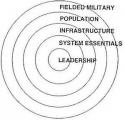Hey Ken - wondering where you'd been lurking at - thought I'd see if we could get you out

Do you really think its egos like we normally think of them? Could it be egos and lack of contextual understanding that prevents us from looking deeper and asking things like: - "wonder why they did things like that?" - until like/similiar conditions roll around and then we say - "hey that sort of makes sense."
I'd not heard about the switch from GPF to MPF. If I took something else like machine guns - and went from GPMG to MPMG would that change the nature and capabilities of that thing, or just the term we used to describe it? The GPMG thing is a bad analogy on my part- machines are not people. Maybe I can answer the broader question I just asked myself - at least take a stab - using the MEU analogy:
General -would mean - good for everything equally, not so good for any thing in particular (goes with the defend everywhere/not strong anywhere) whereas
Multi-Purpose might mean on a particular training cycle the unit was tailored for a specific range - multiple purposes/multi-missions, but not all - like when a MEU SOC does its train up.
This would allow units to be resourced beyond their base MTO&E & train on a range of METL tasks for that cycle - you could have several in the hopper with a different ranges based on the close in Strategic Intel assessment (which is going to be closer to getting it right then one that attempts to go beyond say 6 months to a year) - kind of like standing JTFs.







 just kind of wonder what the problem is. The final effect is best understood from a "Ground Assessment" before you start the cycle over again. Again just my opinion.
just kind of wonder what the problem is. The final effect is best understood from a "Ground Assessment" before you start the cycle over again. Again just my opinion.

 ) has penned here over time has led me to consider my own 22 years differently. Why do we seem to have to constantly relearn things? I'm beginning to think its more a condition then a problem. We're never going to be resourced in time, personnel, equipment, etc. to be prepared for all the military situations which might confront us - nor do I think we've ever been (although there have been time where by virtue of preparing for one thing, we were better prepared for another). As soon as you sink resources into the type of war you fought, or think you fought, or in this case are fighting, but want to conclude, somebody who has been watching you fight and who is concerned you are going to come to their neighborhood decides how to fight you differently enough to where you are not as prepared. Its the nature of an interactive, thinking enemy.
) has penned here over time has led me to consider my own 22 years differently. Why do we seem to have to constantly relearn things? I'm beginning to think its more a condition then a problem. We're never going to be resourced in time, personnel, equipment, etc. to be prepared for all the military situations which might confront us - nor do I think we've ever been (although there have been time where by virtue of preparing for one thing, we were better prepared for another). As soon as you sink resources into the type of war you fought, or think you fought, or in this case are fighting, but want to conclude, somebody who has been watching you fight and who is concerned you are going to come to their neighborhood decides how to fight you differently enough to where you are not as prepared. Its the nature of an interactive, thinking enemy. 
 ) then we can provide an adequate number of Alt and Suppl Msn sets. If the Doctrine says do it, Congress will support it.
) then we can provide an adequate number of Alt and Suppl Msn sets. If the Doctrine says do it, Congress will support it.



 I have a question for all. First the importance of Military Police in SASO seems to have been down played. By that I mean instead of tasking other units to do this or creating a multi-purpose Artillery unit, why don't we just increase the size of MP units?
I have a question for all. First the importance of Military Police in SASO seems to have been down played. By that I mean instead of tasking other units to do this or creating a multi-purpose Artillery unit, why don't we just increase the size of MP units?

Bookmarks